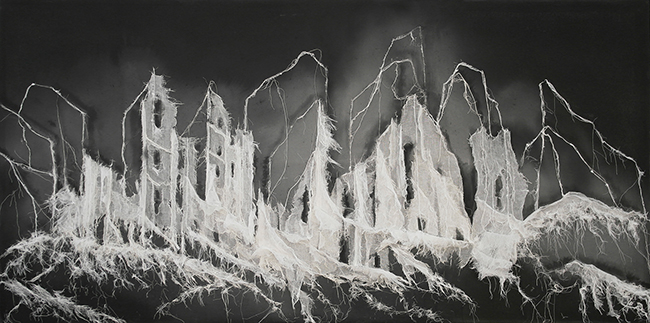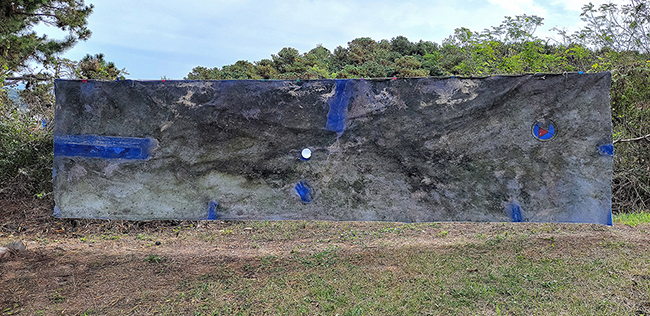2024 국립현대미술관 나눔미술은행 선정
왜곡된 진실, 가볍거나 무겁거나
Twisted Truth, Light or Serious
2024.12.06.-2025.02.23.
강석문 공병훈 권기수 권오상 김경신 김동유 김영호 김영훈 김 인 김지혜 김 진 김진란 김창환 김현준 나광호
노순택 민성홍 박상미 박재영 박준범 박혜수 변재언 서순오 성태훈 손동현 안종대 엄익훈 오창근 유기중 유선태
유재연 윤지용 이길우 이 배 이병호 이보름 이상원 이수홍 이유진 이윤기 이주연 이해민선 임수진 전범주 전희수
정 승 정재호 진마이어슨 차혜림 최금주 최 선 추종완 하임성 하 진 함경아 혜 자 홍성철 홍시연 황미영
진실(眞實)이란 무엇인가? 진실은 사실에 의해 증명된다. 그런데, 우리가 알고 있는 사실은 정확한 것인가? 사실은 기억이라는 회로와 연결돼 있다. 하지만 같은 사실이라도 기억하는 사람마다 사실이 달라질 수 있다. 때문에, 우리는 사실을 기록하지만, 그 또한 기록자와 그것을 해독하는 사람의 해석에 따라 조금씩 의미가 달라질 수 있다. 따라서, 이것에는 판단의 영역이 개입한다. 또한, 진실은 여러 개의 사실을 수렴할 때 조금 더 객관적 진실에 다가갈 수 있다. 이 문제는 학문의 진리(眞理) 영역에서도 작동하게 되는데, 이러한 원리를 통해 론(論)과 법칙(法則)을 만들어낸다. 그래서, 진리(眞理)의 영역은 객관적 진실의 영역을 넘어선다.
그러면, 진실이 객관적 사실들만을 통해서 명확해질 수 있는가? 진실은 연역적이거나 귀납적이거나, 아니면 변증법적이거나 이러한 소위 정보와 지식을 통한 증명 방법을 통해 밝혀내는 이성(理性)의 범주에서만 설명될 수 있는 것은 아니다. 호기심과 의문, 상상, 그리고 가설과 추론의 영역은 이성을 넘어선 반이성의 영역, 즉 초월 이성의 영역으로서 감각과 감성, 그리고 무의식의 영역을 끌어들일 때, 조금 더 가까워질 수 있다. 이는 보다 비과학적이고 비논리적일 수 있다. 그러나, 지식과 이성에 기대어 얻어내는 사실과 진실의 빈자리에 반이성적 사고가 더해졌을 때, 우리는 참 결과, 즉 진실을 마주하게 될 가능성이 커진다.
고대나 중세, 현재도 마찬가지로 ‘사실’은 정보와 증거에 의해 명징해진다. 그러나, 우리는 역사를 통해서 잘못된 사실 인식이 얼마나 많았는지, 또 그것들이 사람들을 어디로 어떻게 이끌었는지 보아왔다. 왜곡된 지식과 정보는 왜곡된 진실을 낳는 것이 자명한 일이나, 그렇다고 아무리 올바른 지식과 정보라 할지라도 완벽한 진실을 낳는다는 보장 또한 없다. 같은 사실과 판단이라 하더라도 ‘그때는 맞았고 지금은 틀렸다.’라는 말이 이에 해당하지 않나 본다. 또한 ‘마녀사냥’이라는 말 또한 이것과 무관하지 않다. 여기서 또 하나 중요한 의미가 ‘인식과 이해’이다. 인간은 어떻게 바라보고 인식하며 이해하느냐에 따라 같은 사실을 서로 다른 사실로 인식하게 된다.
우리는 사회에서 얼마나 많은 사실과 마주하는가? 그리고, 얼마나 다양한 판단을 내놓게 되는가? 이 문제에서 또 하나의 복병을 만나게 된다. 바로 각자의 입장과 시각이다. 같은 사건과 사실이라 할지라도 자신이 처한 상황과 감정에 따라 해석하고, 판단하게 된다. 이쯤 되면 이 진실의 문제는 ‘의식’이라는 겹겹의 커튼 뒤에 숨게 된다. 따라서, 우리는 진실을 직시한다는 것 자체가 매우 복잡하고 힘들 수 있다. 사회의 수많은 문제뿐만이 아니라 각자 개인의 사실에서도 우리가 진실이라고 인식하고 있는 그 사실들이 진실이 아닐 수 있다. 기억의 왜곡이나, 인과(因果)를 둘러싼 내가 모르는 사실이 있을 수 있기 때문이다. 그것은 아프게만 기억되는 하나의 사건과 사실 속에, 다른 입장과 상황에서 어쩔 수 없는 어떤 이유가 숨어있는 것과도 같은 것이다. 따라서 우리가 인식하는 진실이 과연 완벽한 진실인가에 대해서 의심해 볼 필요가 있다. 그렇게 본다면 과연 ‘완벽한 진실이란 존재할 수 있는가?’라는 지점까지 다다르게 된다. 왜곡된 진실을 진실이라 인식하는 것인지, 진실을 나도 모르게 왜곡하고 있는 것인지 말이다.
우리는 이번 〈왜곡된 진실〉이라는 전시를 통해 과연 진실이 무엇인지, 우리는 어떠한 태도로 진실을 마주해야 하는지 재고해 봐야 할 것이다. 특히 인터넷과 소셜네트워크를 통한 정보의 홍수와 지식의 범람 앞에 우리의 정체성과 흔들리는 가치관 또한 점검해 보는 기회가 되었으면 한다. 우리는 보이는 것 뒤에 숨어있는 진실을 통찰해 낼 수 있는 이성에 대한 각성이 지극히 필요한 시점에 서 있다. 이 끝 없는 물음을 생산하는 진실의 문제 앞에 과연 작가들은 어떤 사고와 시각에서 어떻게 세상에 질문을 던지는지 확인하는 것도 이번 전시의 관전 포인트다. 59명의 작가가 가볍게, 때로는 무겁게 던지는 진실의 문제에 대한 담론에 좀 더 진지하게 귀를 기울여 보았으면 한다.
양평군립미술관 학예실장 이홍원
What is truth? Truth is proven by facts. However, are the facts we know true? Facts are connected to the circuitry of memory. Yet, even the same fact can vary depending on who remembers it. Therefore, while we record facts, their meanings can slightly change depending on the recorder and the interpreter. This introduces the realm of judgment. Furthermore, truth approaches a more objective form when multiple facts converge. This principle implies to the academic domain of truth, where theories and laws are derived. Thus, the domain of truth transcends objective facts.
Truth cannot be fully explained within the confines of reason alone, as revealed through deductive, inductive, or dialectical methods of proving information and knowledge. While logos provides a framework for rational thought and order, curiosity, doubt, imagination, hypotheses, and inference push beyond its boundaries into what might be called anti-logos or transcendental reason. This expanded realm incorporates sensation, emotion, and even the unconscious. Though such approaches may seem unscientific or illogical, when irrational thought complements the gaps of fact and verity left by knowledge and reason, we increase the likelihood of encountering genuine truth.
In ancient and medieval times, as well as today, 'facts' are clarified through information and evidence. Yet, history shows us countless cases of misperceived facts and their impact on individuals and societies. Distorted knowledge and information inevitably lead to twisted truths, but even accurate knowledge and information do not guarantee absolute truth. The saying, 'It was true then but is false now,' aptly illustrates this idea. Similarly, the term 'witch hunt' is also related to this phenomenon. Another critical factor here is 'perception and understanding.' Depending on how humans view, perceive, and comprehend the same facts, they may interpret them all differently.
How many facts do we encounter in everyday life? How many judgments do we make? Another obstacle arises here: perspectives and positions. The same events and facts are interpreted and judged differently depending on one’s situation and emotions. By this stage, the problem of truth becomes obscured behind layers of “consciousness.” As a result, facing truth itself can become exceedingly complex and challenging. Not only in societal issues but also in personal matters, the facts we recognize as truth may not be truth. Distortions of memory or unknown causes may surround these facts. They resemble hidden reasons in events or facts that seem painful when remembered but are unavoidable from other perspectives or in different situations. Therefore, we must question whether the truths we recognize are truly complete. This leads us to ask, 'Can perfect truth exist?' Are we recognizing distorted truths as truth, or are we unintentionally distorting truth?
Through this exhibition, “Twisted Truth,' we aim to reconsider what truth is and how we should approach it. In particular, we hope it becomes an opportunity to reflect on our unsettled identities and values amidst the flood of information and knowledge through the internet and social networks. This exhibition provides a valuable opportunity to delve into the ways artists pose questions about the world, their thoughts, and their perspectives on the complex and ongoing pursuit of truth. We hope that audiences will engage deeply with the thought-provoking discussions presented by 59 artists, who approach the question of truth in a variety of ways, at times with a light touch and at other times with a more serious tone. Let us listen attentively to their dialogue.
Lee Hong-won
Director of Curatorial Affairs
Yangpyeong Museum of Art

윤지용, Chessman_King, 2020, 도기에 유약, 판성형, 물레성형, 114×43×43cm

김진란, After the Rain, 2016~2017, 캔버스에 재, 안료, 거즈, 실, 100×200cm, 국립현대미술관 미술은행 소장

전희수, After Dinner, 2022, 214cmx350cm, Acrylic on canvas banner

진마이어슨, PYROKINESIS 2.0, 2023, 캔버스에 유채, 아크릴 폴리머, 150×150cm

김진, N_either 1203, 2012, 린넨에 유채, 180×200cm, 국립현대미술관 미술은행 소장

박재영, Woolscape-sparkle(yolk), 2024, 캔버스에 유채, 65×50cm

안종대,
실상(Le Temps), 2021~, 천, 실, 색지, 569×151cm

이유진, 변성(變性)하는 살(The Flesh Denaturing) , 2007, 유리섬유, 강화 플라스틱, 황동, 136×95×53cm (ed.3/5)










